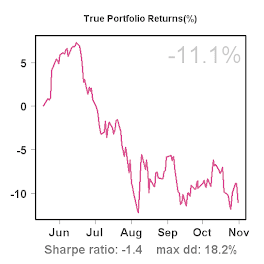Trend Plays #1 Rolling Alpha and Beta
During the past week I have discussed alpha, beta and R-squared for Longstoch-ST and ARS. These statistics are essential in understanding how much better or worse the system did in comparison to some index (e.g. the S&P 500).
I estimated these statistics for a single point in time, using the entire history of the system available at that (most recent) date. However, it is quite possible that alpha and beta vary over time and that will be the topic of the next few posts.
I calculate rolling alpha's, beta's and R-squared in order to track their change over time. I started with the first 100 trading days and calculated the stats. Then I re-estimated everything using day 2-101, then day 3-102 etc. all the way till the last day of the available history. This is a similar approach to the rolling correlations I estimated a few weeks ago.
The graph in the upper-left corner shows rolling 100-day Alpha's for Trend Plays #1 have varied between 0.05% and 0.35%, i.e. the system outperformed the S&P 500 by at least 0.05% per day on average for any 100-day period since its inception. The statistic is always represented by the red line, the blue lines mark the 95% confidence interval. The graph in the upper-right corner (rolling beta) shows that in the beginning the system was a lot more volatile than the index, probably because it used more than 1x leverage at the time. We can see that since it stuck to 1x leverage more recently, beta has always been smaller than 1 for any 100-day period.
The lower-left corner graph shows that R-squared has been fairly low--it fluctuated between 0.15 and 0.30. Again, a low R-squared is desirable in general, but makes alpha and beta harder to interpret. Finally, I have included the 100-day return for the S&P500 in the bottom-right corner. The reason for this is that we always need to judge alpha and beta in light of the movement of the index. For example, normally we don't like zero alpha, but if a system would only show zero alpha during a strong bull market, combined with a high beta for that period, it simply means the system took advantage of the bull market at the right time. This is what seems to have happened with Trend Plays #1 since day 200: Alpha steadily declined, while S&P500 returns increased--which shouldn't be reason for panic in light of the explanation above.
Obviously an interesting question is whether alpha is declining over time. Looking at the graph it seems to fluctuate, but without a clear trend. We can test this formally by extending the standard regression with a linear time trend, i.e. the model is:
R = alpha + beta * I + tau * days,
where R is the system's daily return, I the S&P500 index daily return and days the number of trading days since the start (this is applied to all the data, not just 100 days). If we estimate the parameters of the model (alpha, beta and tau) through linear regression, it turns out that tau equals -0.0008% and alpha 0.30% per day. With such a decline the model would predict an alpha of zero or lower after day 375 (0.3 / 0.0008), which is less than hundred days from now! Fortunately, the standard error for tau is extremely large (0.001%) relative to tau itself, and hence the effect is far from significant. So, it's not something to be worried about currently, but I will keep a close eye on it in the coming months.



No comments:
Post a Comment